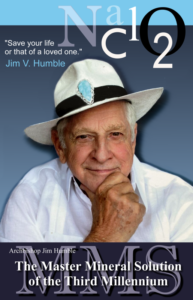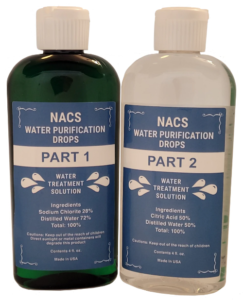Chlorine dioxide is currently gaining attention as a remarkable mineral supplement known as MMS, revered for its potent antimicrobial properties. An assertion by the remedy’s discoverer regarding its efficacy is striking – all 75,000 malaria cases treated were cured within a day, with 98% experiencing recovery within just 4 hours. Such outcomes hold immense significance not only for self-healing but also for the medical and pharmaceutical sectors. This discourse aims to provide insights into these matters.
Chlorine dioxide finds application in numerous countries, including Australia and the USA, as an antimicrobial treatment in the food industry, water purification, and the sterilization of hospital and clinic environments. Hospitals have employed it as a disinfectant for a century, while the US meat industry has incorporated it for approximately 50 years. Health-conscious regions are progressively replacing harmful chlorine with benign chlorine dioxide for treating public water supplies.
In solution, sodium chlorite is notably alkaline and stable. However, when subjected to acidification, it generates chlorine dioxide (ClO2), possessing a scent similar to chlorine. This compound is possibly the most effective all-encompassing antimicrobial and parasite remedy. Remarkably, it targets anaerobic microbes and parasites without harming beneficial lactobacteria in our intestinal flora. Following treatment with MMS, the only residual substance left in water, food, or the body is a small amount of table salt or sodium chloride (NaCl).
In 2003, the Australia New Zealand Food Standards Code was revised to allow the utilization of chlorine dioxide for antimicrobial surface treatment of meat, poultry, fish, fruits, and vegetables. The application duration is less than 5 minutes, and chlorine dioxide levels do not exceed 3 ppm. Safety assessments confirmed that no detectable residues would remain in raw foods post-treatment, assuaging any toxicological concerns prior to sale.
Commercially, chlorine dioxide is distributed in Australia as a 31% water solution. For food and agricultural industry end-users, a 5% solution named Vibrex is available. Tablets that release 4 ppm per 1 liter or per 30 liters of water are also accessible in the US and the UK. In Germany and Italy, chlorine dioxide serves as the primary treatment agent for public water supplies.
Interestingly, chlorine dioxide has been patented for intravenous use in treating autoimmune diseases, hepatitis, and lymph cancers. It is purported to prevent or minimize antigen activity and autoimmune responses.
Chemist and metallurgist Jim Humble accidentally discovered MMS when he used chlorine dioxide to swiftly cure a companion of malaria during a jungle expedition. Since the hospital disinfectant was unsuitable for human ingestion, Humble embarked on researching a safe dosage and procedure to harness the potential of this highly effective antimicrobial for human use. He settled on a nominally 28% solution that, due to a sodium chloride content of nearly 20%, actually contains only 22.4% sodium chlorite. Given its astounding immune-boosting effects against invading microbes and parasites, Humble aptly named his chlorine dioxide the Miracle Mineral Supplement, or MMS for short. Nevertheless, Miracle Mineral Solution is a more fitting moniker, as supplements necessitate health authority approval, while a solution for water treatment doesn’t require registration.
With a maximum dose of up to 3 x 15 drops, Humble attests that “MMS is producing some of the quickest results that I have seen with people’s health, including cancer, diabetes, arthritis, shingles, warts going hard and dropping off, and many more.” Even AIDS patients in debilitated states regained their health and returned to work without signs of disease.
Chlorine dioxide shows exceptional efficacy against diseases related to microbes and immune responses, encompassing infections, autoimmune conditions, and a range of other ailments. It was even used to combat Anthrax during the 2001 Anthrax attack. Notably, even diseases not conventionally linked to microbes and the immune system reportedly showed improvement.
In a surprising occurrence involving MMS, Humble recounts the story of a teenage girl. She was overweight, grappling with depression, and experienced delayed breast development. After being administered MMS, her breasts started growing the next day. Subsequent doses led to her first period after a 6-month hiatus, her breasts fully developing, her depression lifting, and her weight decreasing. Candida could have potentially caused her issues.
Due to its robust oxidizing capabilities, chlorine dioxide seems to neutralize numerous toxins, possibly alleviates toothache, and renders stored heavy metals soluble for easier expulsion. Another advantage over chlorine is that chlorine dioxide does not react with organic matter like food, body cells, or our beneficial gut bacteria. Instead, it specifically targets pathogenic microbes. However, it may react with vitamin C and other reactive antioxidants.
Widespread awareness and use of this treatment option could pose a challenge to the medical-pharmaceutical complex. The FDA has a history of taking action against inventors of effective natural remedies and therapies that threaten the pharmaceutical industry’s interests. Jim Humble, being an American, opts to remain concealed in Africa or Central America to protect himself.
It is essential to clarify that MMS is intended for water purification and not for human treatment. Through this process, we can consume purified water, which subsequently enhances our immune system. The recommended approach typically involves commencing with 1 or 2 drops of MMS and gradually increasing the dosage to 15 drops thrice daily. Combine MMS with an acid activator, with a 10% citric acid solution in water being the most preferred. You can easily make this solution by dissolving 1 spoonful of citric acid crystals in 9 parts water, often found as a baking ingredient in supermarkets. Acid activation triggers the release of chlorine dioxide.
At this concentration, the aroma of chlorine dioxide becomes more potent, and its impact on microbes and parasites intensifies. Thus, more challenging conditions like Lyme disease, which is caused by a tick-transmitted virus, responded to 15 drops of MMS acidified with 10% citric acid, unlike other concentrations.
The overarching strategy is to gradually increase the MMS quantity until the immune-related issue is resolved.
Three minutes after acid addition, dilute the mixture with half a glass of water and optionally include herb tea or juice lacking added vitamin C (e.g., apple or grape juice, but not orange juice). Cinnamon alone or with a touch of honey can help mask any undesirable taste. The previously strong smell lessens as chlorine dioxide remains dissolved in water. Avoid antioxidant supplements close to MMS consumption. If the taste is overly acidic, you can neutralize the liquid with sodium bicarbonate just before drinking.
Consume the diluted MMS all at once or space it out in sips over an hour or two to minimize potential nausea. Although it works best on an empty stomach, this can also lead to nausea. If nausea occurs, temporarily decrease the dose or have a small meal. Alternatively, consider taking a dose (e.g., 6 drops) followed by another dose an hour later. This double-dose approach appears more effective than a single dose repeated multiple times in the day. However, the highest double dose, such as two times 15 drops, might induce vomiting in some individuals.
Taking MMS before bedtime might be advantageous. MMS acts quickly, often causing drowsiness. Falling asleep can be easier when dealing with potential nausea. For those taking MMS twice a day, one of the doses could be in the evening before sleep. However, individual responses vary, and some people might find it challenging to sleep after taking MMS.
Jim Humble believes that giving children MMS for infections is safe. The suggested maximum dose for children, whether underweight or overweight, is 3 drops per 25 pounds of body weight. It might be more prudent to consider a range of 2-3 drops per 25 pounds as the maximum dose.
For most situations, Humble considers the intensive MMS treatment completed after consuming 15 drops two or three times daily for a week. If this dosage isn’t attainable, remaining at the highest manageable dose for a bit longer is advisable. Subsequently, Humble suggests a maintenance intake of 6 drops daily for older individuals and 6 drops twice weekly for younger ones.
Personally, I undertake a yearly maintenance cleanse by consuming three drops of MMS in 4 ounces of water every hour when awake, over the course of three weeks, or when an emerging infection necessitates it. This practice might not apply universally and can depend on individual conditions. For instance, if someone has root canal fillings or biofilms on surgical implants – environments that can’t be instantly sanitized – several drops of MMS daily might be recommended until the situation improves. Similarly, if a sufficiently high dose cannot be reached for eliminating harmful microbes and their spores, it could be more beneficial to extend periods on a lower, discomfort-free dose.
In situations involving severe acute infections or poisonings, such as with malaria, Humble suggests an immediate dosage of 15 drops, followed by an additional 15 drops after an hour. Although most conditions tend to improve with a medium dose administered over an extended period, specific parasitic and viral conditions may require at least one high double dose to yield results. Interestingly, it appears that high double doses are more manageable with life-threatening acute conditions than with chronic ones.
For chronic or longstanding conditions, gradually increase the drop count over several weeks. An optimal approach is to add 1 drop each day until slight nausea is experienced. On the next day, reduce the count by 2 drops and maintain this level for several days before resuming the gradual daily increase of 1 drop. This method allows for a gradual ascent, alternating between reduction and elevation to control nausea. If you’re experiencing discomfort, consider dividing the daily dose between morning and bedtime portions. However, aim to incrementally elevate until nausea is triggered. If consistent nausea persists upon dose elevation, maintain a dose level that doesn’t cause issues. Over time, nausea with vomiting or diarrhea might emerge anyway, but it’s preferable to a high dose of MMS rather than a low one.
For acute infections, starting with 3 or 4 drops and increasing rapidly, even if accompanied by nausea, vomiting, or diarrhea, is suitable. Severe parasite issues like a malaria attack, poison ingestion, food poisoning, or snake bites often respond positively to a high double dose of MMS.
Addressing conditions like abscessed teeth, infected gums, and pyorrhea involves using 6 drops of acidified and diluted MMS for rinsing, and holding the mixture for several minutes. For a sore throat, frequent gargling with MMS is recommended. Additionally, adjusting the dilution by adding more water, tea, or juice and experimenting to find the effective dose can be beneficial.
For sinus infections, inhaling chlorine dioxide through each nostril can be attempted, although it might cause mucous membrane irritation. This method should be exercised with caution.
For inflammatory and infectious skin conditions, diluted acidified MMS can be used for bathing or washing the affected area. Cases of psoriasis reportedly improved after a few weeks of topical MMS treatment. For autoimmune diseases like scleroderma, leukoderma/vitiligo, or autoimmune-related baldness, both internal and external MMS applications could be considered.
For burns, Humble advises applying full-strength MMS directly onto the burn without using acid. Gently spreading it over the burn and allowing it to remain for 30 seconds to a minute can neutralize the acidic chemical. Washing off the MMS with water is crucial to avoid worsening the burn. Correct application can lead to faster healing compared to untreated burns. In the case of sunburns, applying MMS for 15 to 30 seconds followed by rinsing with water is recommended.
To alleviate nausea and potentially assist with conditions like bowel cancer or inflammatory bowel issues, utilizing activated MMS in half a liter of water as a retention enema might be considered. Preceding this with another enema or using a laxative to cleanse the bowels could enhance its efficacy. For cancers of the uterus, cervix, or ovaries, insertion of the activated solution in a non-irritating concentration could be explored.
Regarding colds, MMS targets the virus while allowing beneficial mucus release. Halting mucus secretion can be achieved through the Sugar Cure: holding a teaspoon of fine sugar in the mouth until it dissolves, then spitting it out and repeating with another teaspoonful. This practice draws mucus and lymph fluid from lymph glands, gradually clearing the headspaces.
For influenza, it’s advisable to take several high doses of MMS for one or two days, followed by substantial amounts of sodium ascorbate (e.g., half a teaspoon in liquid like fresh citrus juice) every two hours until recovery.
Individuals might encounter challenges in continuing with the MMS regimen due to frequent episodes of nausea. This issue can become particularly pronounced in cases of advanced cancer and other persistent conditions. Therefore, it’s worth considering an approach involving milder agents for intestinal sanitation and antimicrobial therapy prior to commencing MMS treatment. This preliminary strategy aims to alleviate a substantial portion of the toxic burden with less discomfort compared to immediate initiation of MMS. As part of this preliminary process, contemplating a 3-week period of Lugol’s solution or a less concentrated form of aqueous iodine, alongside a course of water purified with MMS, could be beneficial.
For some individuals grappling with advanced degenerative diseases, weakness induced by MMS therapy, seemingly unrelated to die-back reactions, can occur. This phenomenon is possibly linked to antioxidant deficiency, particularly a lack of glutathione. In this context, introducing 1 gram of N-Acetyl Cysteine daily could stimulate glutathione production and contribute to expelling toxic minerals.
Frequently, episodes of nausea, vomiting, and diarrhea manifest sooner or later during the course of treatment and can be regarded as advantageous for purging toxins. Occasionally, other reactions like inflammations might be temporary. To counteract nausea, an option is to take 1000 mg or more of vitamin C, although this might simultaneously halt the antimicrobial activity. Alternative methods that could help alleviate nausea encompass vitamin B6, ginger, exerting pressure an inch below the wrist at the midpoint of the underarm, and reflexology – applying pressure to the foot reflex corresponding to the stomach, located just below the joint of the big toes, utilizing a pointed stone, a corner of furniture, or a step.
Furthermore, a significant reduction in nausea can often be achieved by performing bowel cleansing before taking drops or immediately upon nausea onset. This can be achieved through an enema, colonic, or appropriate laxative prior to the emergence of nausea. Moreover, for cases involving bowel cancer or inflammatory bowel conditions, considering the use of activated MMS in half a liter of water as a retention enema might be valuable. Preceding this with another enema or utilizing a laxative for bowel cleansing is recommended. For instances of cancer affecting the uterus, cervix, or ovaries, some have experimented with introducing the activated solution in a non-irritating concentration.
Concerning cardiovascular diseases and arteriosclerosis, there’s a suggestion that MMS therapy could result in the rapid removal of cholesterol deposits, potentially leading to the weakening of affected blood vessels. To minimize or prevent such issues, Dr. Matthias Rath proposes a strategy of consuming high doses of vitamin C – up to 10 g daily in divided portions – for several weeks before initiating MMS therapy. This measure is intended to fortify blood vessels and enhance their elasticity. Additional nutrients that can contribute to improved elasticity include lemon juice, green juices, copper salicylate, magnesium chloride, MSM, and N-Acetylglucosamine. In cases of cancer, some individuals also explore supplementary therapies as advised by natural alternative specialists.
In addition to nausea, inflammation can also emerge as a potential side effect of MMS therapy. To comprehend this effect, it’s necessary to delve into the function of inflammation and the interplay of oxidants and antioxidants in this process. Inflammations serve to enhance blood circulation and nutrient supply to a particular region, playing a crucial role in enabling the immune system to function effectively and facilitating the recovery of injured organs and tissues. However, if the immune system is not sufficiently robust to eliminate invading microbes and diseased cells, the initially healing immune-driven inflammations can transition into destructive chronic inflammations. This transition is a hallmark of the prevailing epidemic of chronic diseases.
Oxidants play a supporting role in bolstering the immune system. They combat microbes directly and empower the immune system with heightened efficacy. Consequently, the utilization of potent oxidants like chlorine dioxide can lead to escalated inflammation. Thus, during the course of MMS treatment, akin to any genuine enhancement in health, several healing reactions may manifest, including temporary inflammations. While these may cause momentary discomfort, they contribute to long-term healing.
Conversely, the suppression of inflammation is evident in the conventional medical application of anti-inflammatory steroids for managing autoimmune conditions. Many practitioners have observed that these diseases can be effectively addressed within weeks or months using natural methods. However, the concurrent usage of steroidal drugs often hinders progress. In such cases, the immune activity that results in heightened inflammation is inhibited by the steroids. Nonetheless, it’s unwise to substantially reduce anti-inflammatory drugs until measures like sanitizing the intestines and addressing infected teeth are undertaken, and after completing antimicrobial therapy.
Antioxidants possess the opposing function to oxidants. They shield our cells and functions from oxidative damage. Oxidation should occur solely within well-regulated pathways for energy production or to combat invaders and harmful agents. Intensifying oxidant intake necessitates a corresponding increase in antioxidant intake, or else unnecessary inflammations and tissue irritation may arise, leading to degenerative changes. An instance of this is the potential deterioration of eyesight after prolonged high-dose usage of MMS.
Antioxidant deficiency is prevalent in cases of chronic diseases and advancing age. Elevated MMS intake exacerbates this deficiency. Hence, it’s crucial to heighten antioxidant consumption when using MMS. However, the intake of oxidants and antioxidants should be spaced apart during the day to prevent mutual neutralization. For example, MMS could be taken before breakfast and bedtime, while antioxidants are consumed from mid-morning until the evening meal.
This advice pertains not only to antioxidant supplements like vitamin C, E, B-complex, coenzyme Q10, or grapeseed extract, but also to antioxidant-rich foods such as purple berries, fresh fruits, polyunsaturated oils, turmeric, black or green tea, and cocoa. As chlorine dioxide has a particular affinity for vitamin C, taking 1 gram or more of it while on a high dose of MMS for an extended period can help safeguard oxidation-sensitive structures like the heart, brain, and eyes.
In cases of sodium chlorite overdose – consuming more than ½ teaspoon of the miracle mineral solution – it’s crucial to immediately consume copious amounts of water. It’s advisable to add ½ teaspoon each of bicarbonate of soda and sodium ascorbate to each glass of water, if available. After drinking ample water, inducing vomiting may also be attempted.
Remember to shield MMS Water Purification Drops from direct sunlight.




